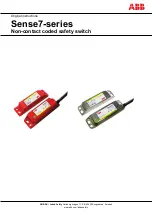
Section 9
:
Instrument Control Library (ICL)
Series 3700 System Switch/Multimeter Reference Manual
9-96
Document Number: 3700S-901-01 Rev. A / August 2007
dmm.limit[Y].high.fail
where Y = 1 to 2 for limit
number
Remarks
This attribute returns the results of
high
limit Y testing:
0 indicates test passed
– measurement within the
high
limit
1 indicates test failed
– measurement has exceeded
high
limit
A failed indication does indicate the high limit caused the failure. You may read the
measurement event register of the status model to see fail indication as well. The
response only has meaning if lower limit Y is set as the triggersource to a digio line.
Otherwise, it will indicate the results of the last limit test when enabled.
Example
To query the test results of high limit 2:
results = dmm.limit[2].fail.high
dmm.limit[Y].high.value
where Y = 1 or 2 for limit
number
Attribute
Indicates the high limit value for limit Y.
Usage
To read the high value of limit Y:
value = dmm.limit[Y].high.value
To write the high value of limit Y:
dmm.limit[Y].high.value = value
value
: Valid range of -4294967295 to +4294967295
Remarks
Use this attribute to specify or query the high limit value of limit Y. When limit Y testing
is enabled (digio.trigger[N].triggersource = dmm.trigger.EVENT_LIMIT1_HIGH or
dmm.trigger. EVENT_LIMIT2_HIGH), the measurement value must be greater than
this value to avoid causing a fail indication for the limit. The default value is 1 for limit 1
and 2 for limit 2. You may set or get the value regardless if the limit is set to a digio
triggersource.
Also see
dmm.limit[Y].high.fail
(on page 9-95)
dmm.limit[Y].low.value
(on page 9-97)
Example
To set high limit of limit 2 to 5:
dmm.limit[2].high.value = 5
dmm.limit[Y].low.fail
where Y = 1 or 2 for limit
number
Attribute
Query for the low test results of limit Y.
Usage
To read the low fail indication of limit Y:
value = dmm.limit[Y].low.fail
















































